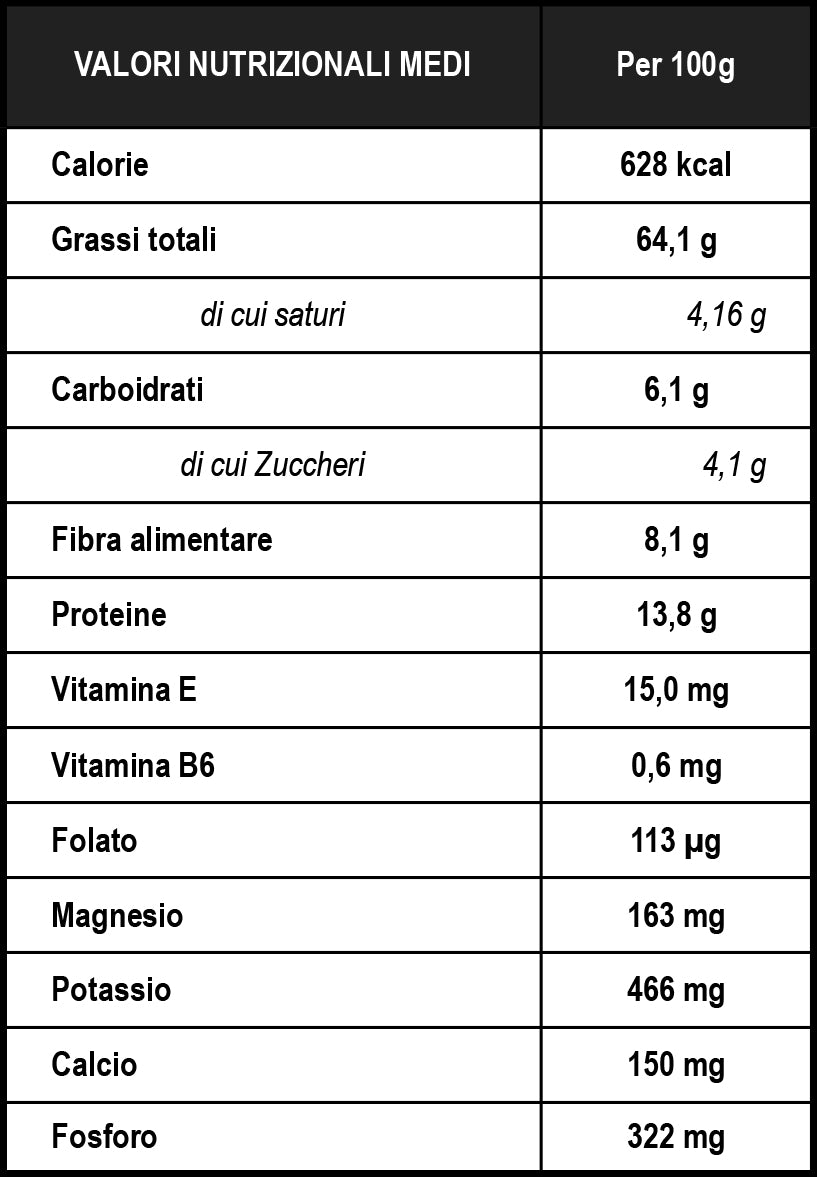
Hazelnut: A Treasure for Health and Low Carb Diet

Types of Hazelnuts in the World
Hazelnuts are grown in different parts of the world and each region has its own distinctive varieties. Here are some of the most important types of hazelnuts:
1. Nocciola Tonda Gentile delle Langhe (Italy) This Italian variety, also known as Nocciola Piemonte IGP, is considered one of the best in the world thanks to its delicate flavor and crunchy texture. It is grown mainly in the Langhe, in Piedmont, and is highly appreciated for the production of sweets and spreadable creams.
2. Giffoni Hazelnut (Italy) Grown in the province of Salerno, in Campania, the Giffoni Hazelnut has obtained the IGP recognition for its quality. It is characterized by an intense and aromatic flavor, ideal for use in pastry making and in the production of chocolate.
3. Hazelnut Romana (Italy) This variety is grown mainly in Lazio, in the province of Viterbo. It is appreciated for its sweetness and is often used in the production of nougat and other traditional sweets.
4. Oregon Hazelnut (USA) Oregon hazelnuts are one of the main varieties grown in the United States. They are known for their size and rich flavor, and are used both for direct consumption and for the production of hazelnut oils and butters.
5. Hazelnut Round of Seville (Spain) This Spanish variety is highly prized for its flavour and texture. It is grown mainly in Andalusia and is used in many traditional Spanish recipes.
Historiographical Notes on Hazelnuts in Italy
Hazelnuts have a long history in Italy, dating back to Roman times.
The Romans were great consumers of hazelnuts, which they considered not only a food, but also a symbol of health and prosperity. Pliny the Elder, in his "Naturalis Historia", mentions hazelnuts as one of the most appreciated foods of the time.
In the Middle Ages , hazelnuts continued to be a staple food, used not only for direct consumption but also as an ingredient in the production of hazelnut oil. This oil was used both in cooking and as a base for ointments and medicines.
During the Renaissance , Italian hazelnuts began to gain international fame. Hazelnut recipes spread throughout European courts, helping to cement Italy's reputation as a center of fine gastronomy.
In the 19th century , hazelnut cultivation became more organized, with the creation of consortia and producer associations. This led to an improvement in cultivation techniques and product quality, making Italian hazelnuts even more appreciated worldwide.
Nutritional Properties of Hazelnuts
Hazelnuts are a rich source of essential nutrients. Let's take a closer look at what makes them so special: ..

Health Benefits
Hazelnuts are much more than just a snack. They are a real concentrate of health. Here are some of the main benefits:
1. Cardiovascular Health Hazelnuts are rich in monounsaturated fats, which are known to be heart-healthy. These fats help reduce LDL ("bad") cholesterol levels and increase HDL ("good") cholesterol levels. Additionally, hazelnuts contain phytosterols, plant compounds that further help reduce cholesterol.
2. Powerful Antioxidants Hazelnuts are an excellent source of vitamin E, a powerful antioxidant that protects cells from free radical damage. This can help reduce the risk of chronic diseases such as cancer and heart disease, as well as delay skin aging.
3. Nervous System Support Thanks to their content of B vitamins, especially vitamin B6 and folate, hazelnuts support the health of the nervous system. These nutrients are crucial for the production of neurotransmitters, which regulate mood and sleep.
4. Improved Digestion The high fiber content of hazelnuts helps maintain regular intestinal transit and prevent digestive problems such as constipation. Dietary fiber also promotes a healthy gut microbiome, which is essential for overall health.
5. Weight Management Despite being high in calories, hazelnuts can help with weight management. This is because the fiber and protein in hazelnuts increase the feeling of satiety, thereby reducing appetite and food intake for hours to come. Additionally, the combination of essential nutrients and healthy fats in hazelnuts can help maintain stable energy levels, reducing the risk of binge eating or unhealthy snacking.
6. Bone Health Hazelnuts are a good source of minerals such as magnesium, calcium, and phosphorus, which are crucial for maintaining strong, healthy bones. Magnesium, in particular, plays an important role in regulating calcium in the body, which is essential for the formation of bones and teeth.
7. Blood Sugar Control Hazelnuts have a low glycemic index, which means they do not cause sudden spikes in blood sugar levels. This makes them a great choice for people with diabetes or anyone trying to keep their blood sugar levels stable.
8. Anti-Inflammatory Properties Hazelnuts contain bioactive compounds such as phytosterols and omega-9 fatty acids, which have been shown to have anti-inflammatory properties. These compounds can help reduce inflammation in the body, which is often the basis of many chronic diseases.
Hazelnut in Low Carb Diet
Hazelnuts are a great ally for those on a low-carb or keto diet. Let's take a closer look at why: 1. Low in Net Carbs Hazelnuts contain 17 grams of total carbs per 100 grams, but thanks to their high fiber content, the net carbs are only 7 grams. This makes them ideal for keeping the carb intake low in your diet. 2. High in Healthy Fats Low-carb and keto diets rely on increasing your intake of healthy fats to promote ketosis, a metabolic state in which your body burns fat for energy instead of carbohydrates. Hazelnuts, with 61 grams of fat per 100 grams, are perfect for this purpose. Plus, the monounsaturated fats that predominate in hazelnuts are known to benefit your metabolism and heart health. 3. Rich in Essential Nutrients Following a low-carb diet may result in a reduction in some nutrients. Hazelnuts, being rich in vitamins and minerals such as vitamin E, magnesium and copper, help fill these nutritional gaps, ensuring a complete supply of essential nutrients. This is especially important for maintaining optimal health in the long term. 4. Versatility in the Kitchen Hazelnuts can be used in many low-carb recipes, from salads to desserts, to sauces and dressings. Their versatility makes them a valuable ingredient for anyone who wants to vary their diet without compromising on taste or health. They can be used whole, chopped, or in the form of hazelnut flour to create a variety of delicious and nutritious dishes.
Comparison with Other Dried Fruits
To better understand the importance of hazelnuts in the low carb diet, let's see a comparison with other popular dried fruits:..

As we can see, hazelnuts have a similar calorie and fat content to other nuts, but they offer a good balance of fiber, carbohydrates, protein and calories, making them particularly beneficial in a low-carb diet. In addition, their nutritional profile makes them an excellent choice for those looking to balance their calorie intake with high-quality nutrients.
The Sustainability of Hazelnut Cultivation
Another important aspect to consider is the sustainability of hazelnut cultivation. Hazelnuts require less water than other nut crops, such as almonds. Additionally, hazelnut trees can be grown in agroforestry systems, contributing to biodiversity and soil conservation. Choosing organic or sustainably grown hazelnuts can make a big difference to the environment.
1. Reduced Water Consumption Hazelnut cultivation is relatively less water intensive than other nut crops. This is especially important in an era where water scarcity is a growing global concern.
2. Soil Conservation Hazelnut trees can help prevent soil erosion. Their roots help keep the soil stable, reducing the risk of landslides and soil degradation, especially in hilly regions.
3. Biodiversity Hazelnut plantations, when integrated into agroforestry systems, can contribute to biodiversity. These systems combine trees with crops or pastures, creating a more diverse environment that is resistant to disease and pests.
4. Environmental Impact Choosing organic or sustainably grown hazelnuts can reduce the use of chemical pesticides and fertilizers, thus benefiting the environment. In addition, sustainable farming practices promote soil health and the conservation of natural resources.
Risks and Considerations
Despite the many benefits, it is also important to consider some precautions:•
Allergies: Like other nuts, hazelnuts can cause allergic reactions in some people. It is important to be aware of any food allergies before consuming them.
Calories: Hazelnuts are high in calories, so it is important to consume them in moderation, especially if you are trying to lose weight.
Using Hazelnuts in Cooking
Hazelnuts are incredibly versatile in the kitchen and can be used in a variety of dishes. Whether used whole, chopped, toasted, or ground into flour, they add a unique flavor and pleasant crunch to many recipes.
Sweets
Hazelnuts are a fundamental ingredient in many desserts, such as cakes, biscuits and spreads. Their rich flavour pairs perfectly with chocolate, creating delicious combinations that are appreciated all over the world. Famous products such as nougat and gianduia owe their success to the use of hazelnuts.
Savoury Dishes
In addition to sweets, hazelnuts can be used in savory dishes to add a crunchy, savory note. They can be chopped and added to salads, used to bread meats or fish, or incorporated into sauces and pasta dressings.
Drinks
Hazelnuts are also used in the production of beverages, such as hazelnut milk, a delicious plant-based alternative to cow's milk, appreciated both for its flavor and its nutritional benefits.
Oils and Butters
Hazelnuts are also used to make oils and butters, both in cooking and in cosmetics. Hazelnut oil is particularly appreciated for its delicate flavor and emollient properties, while hazelnut butter is a rich and nutritious spreadable delight.
Final Considerations
Incorporating hazelnuts into your daily diet can provide numerous health benefits. In addition to being delicious, they are extremely nutritious and versatile. Whether you are following a low-carb diet or simply want to improve your diet, hazelnuts can play a vital role. Experiment with hazelnuts in different preparations and discover how this small nut can make a big difference in your health and well-being.
Conclusion
Hazelnuts are a true superfood, packed with essential nutrients and health benefits. They are especially useful in a low-carb diet due to their low net carb content, high healthy fat content and versatility in the kitchen. By incorporating hazelnuts into your daily diet, you can enjoy numerous health benefits and maintain a healthy and balanced lifestyle. So, next time you are looking for a snack or an ingredient to enrich your recipes, choose hazelnuts and discover all they can offer to your well-being. This article does not pretend to be exhaustive, but it does aim to offer some useful ideas and information to deepen your knowledge of hazelnuts and their benefits. We encourage all readers to continue their personal research, further exploring this fascinating nut. We also remind you that the introduction of hazelnuts into your diet, like any other dietary change, should be done in agreement with your dietitian or nutritionist. Each individual has specific nutritional needs and an expert can provide personalized advice to ensure that nuts, or any other food, are incorporated healthily and appropriately into your daily diet.
